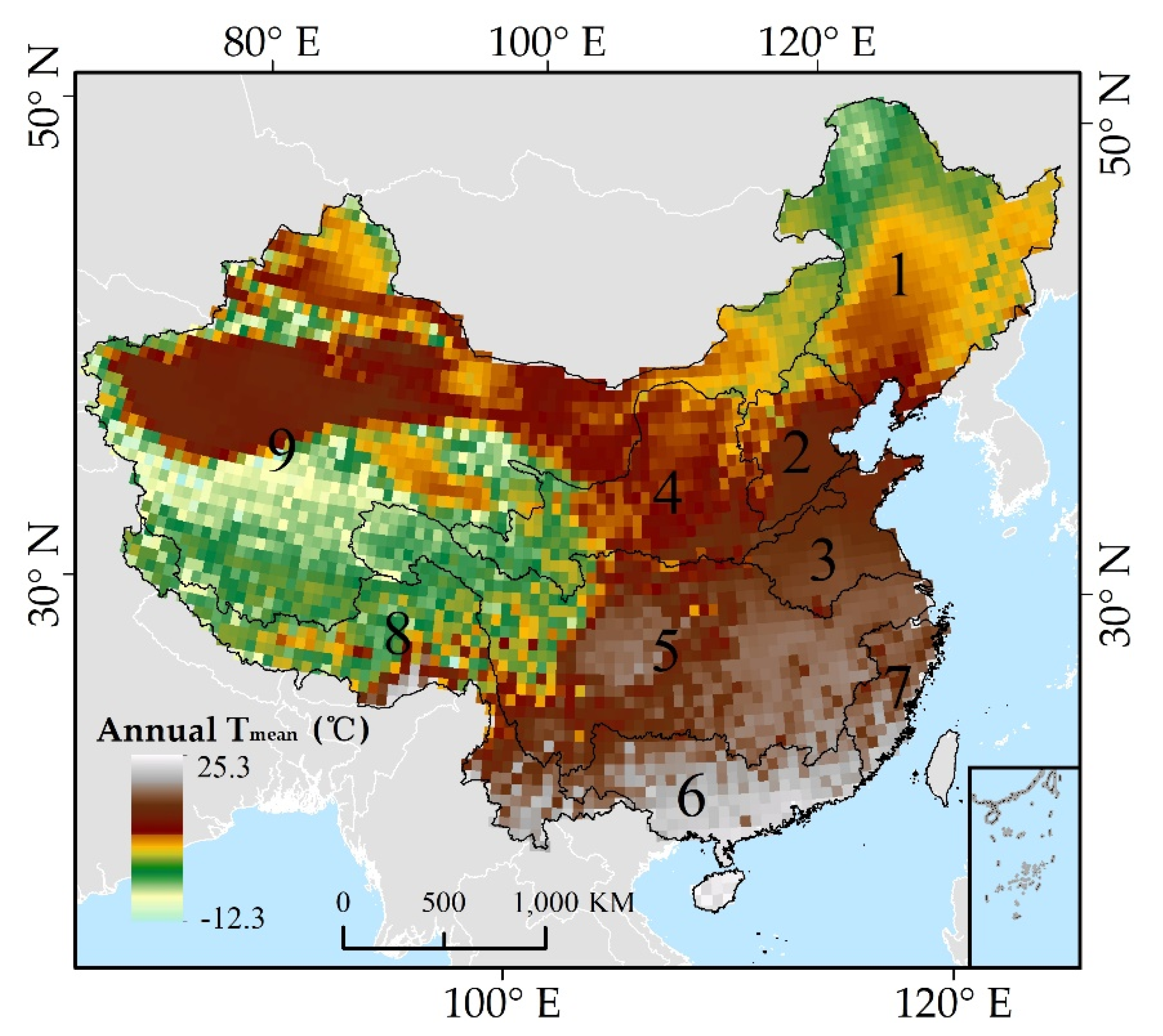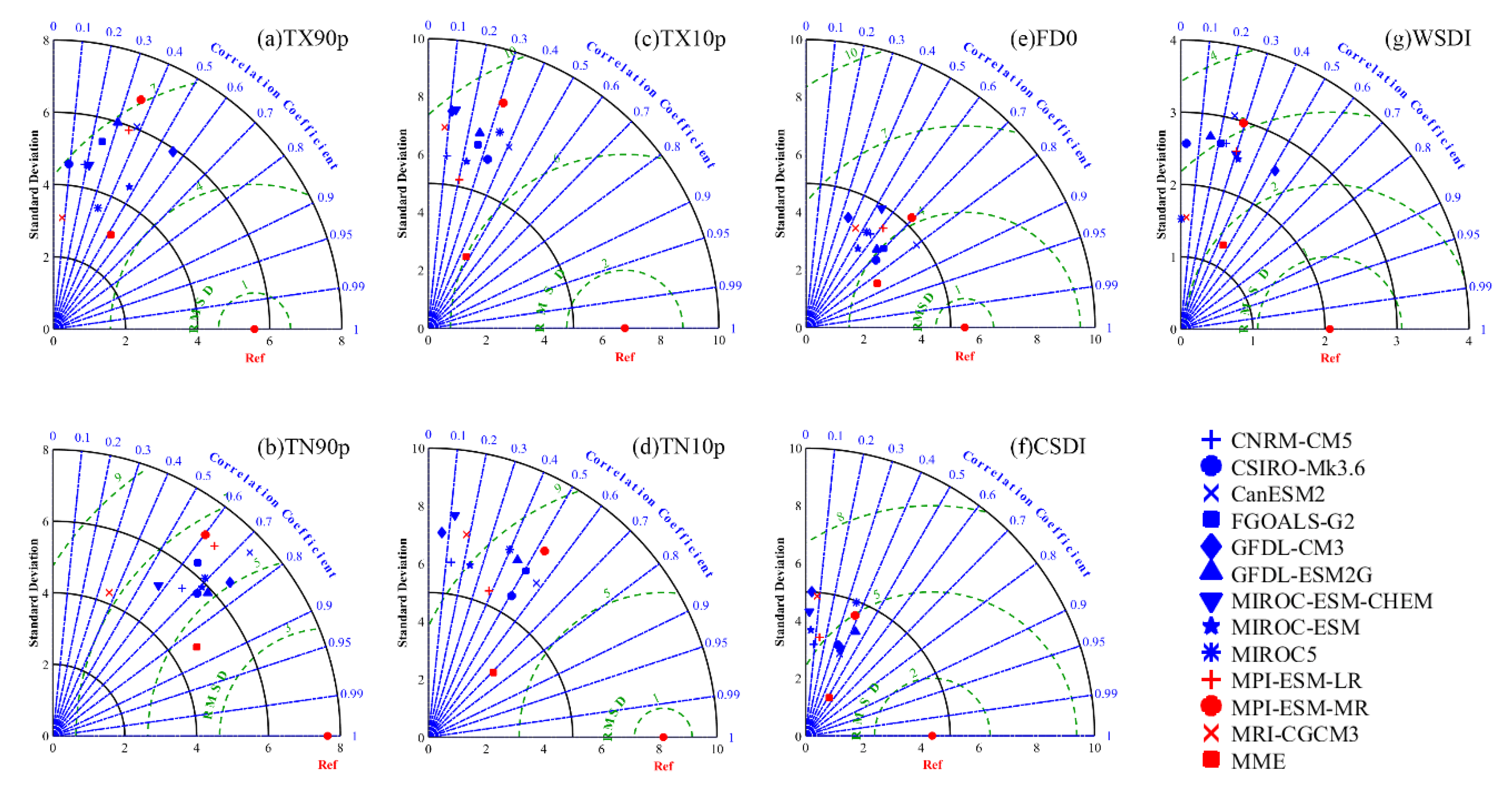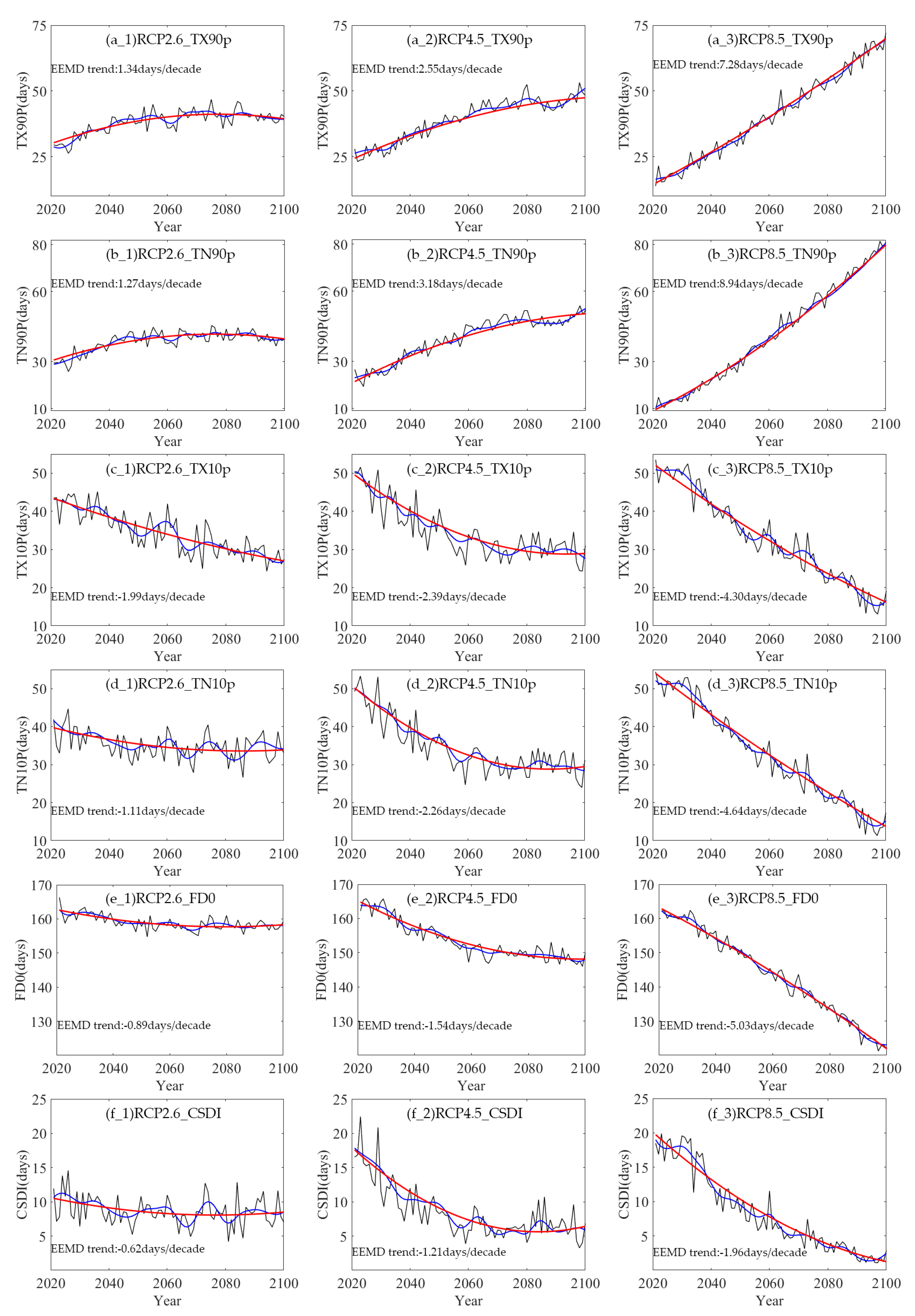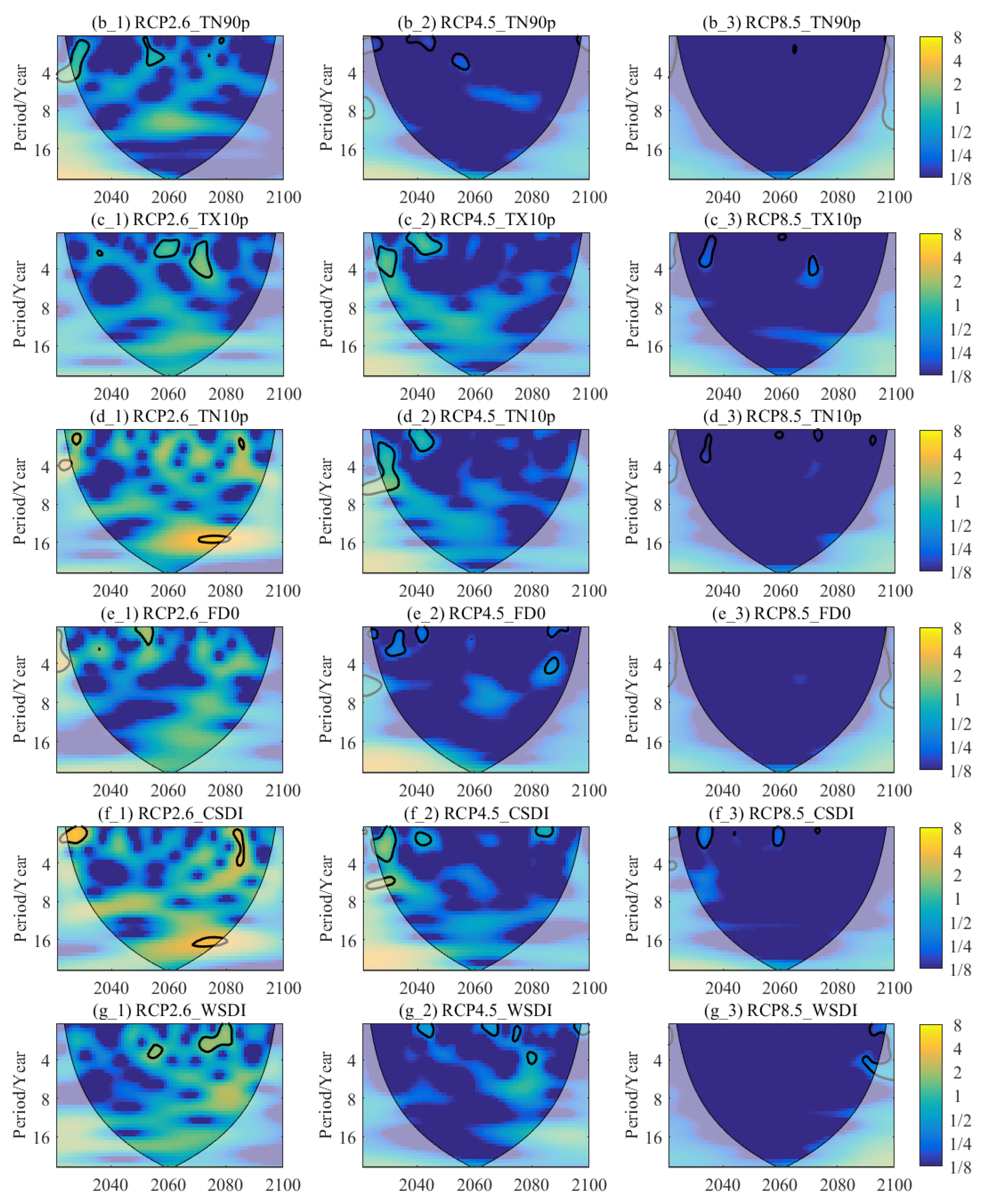CMIP5-Based Spatiotemporal Changes of Extreme Temperature Events during 2021–2100 in Mainland China
Abstract
:1. Introduction
2. Data and Methods
2.1. Data
2.1.1. Observed Climate Data
2.1.2. CMIP5 Data
2.2. Methods
2.2.1. Extreme Temperature Indices
2.2.2. Taylor Diagram
2.2.3. Ensemble Empirical Mode Decomposition
2.2.4. Continuous Wavelet Transform
2.2.5. Sen′s Slope + Mann-Kendall Test
3. Results
3.1. Performances of Models
3.2. Future Temporal Changes of ETI
3.3. Future Periodic Oscillation of ETI
3.4. Future Spatial Changes of ETI
4. Discussion
5. Conclusions
- (1)
- For the 12 models that simulate 7 ETIs, the MME has the best simulation effect, compared to the single model.
- (2)
- For the future temporal changes of the ETI, the warm indices (i.e., the TX90p and TN90p) and the WSDI increase slowly under the RCP2.6 scenario, rapidly under the RCP4.5 scenario, and extremely under the RCP8.5 scenario. In contrast, the decrease of cold indices (i.e., the TX10p, TN10p, and FD0) and the CSDI under the RCP2.6, RCP4.5 and RCP8.5 scenarios are slowly, rapidly, and extremely, respectively.
- (3)
- For the future periodic oscillation of the ETI, the ETIs from 2021–2100 under the RCP2.6 and RCP4.5 scenarios have primary periods, ranging from 1–16 years, with the significance periodic of 1–4 years, but insignificance under the RCP8.5 scenario.
- (4)
- For the future spatial changes of the ETI, under the RCP2.6 and RCP4.5 scenarios, the changes of warm indices are relatively largest in the central and south-eastern basins. Under the RCP8.5 scenario, the changes are relatively large, except for northeast basin. The cold indices show the most significant decreasing trend in the Tibetan Plateau and its surrounding areas, under the 3 RCP scenarios. The decrease trend of the CSDI is the most significant trend in the central, a part of north-western, and the southwestern basins. The increase trend of the WSDI in the south-east and north-west of China is the largest and the most significant trend.
Supplementary Materials
Author Contributions
Funding
Conflicts of Interest
Abbreviations
| Acronyms | Description |
| CMIP5 | Phase5 of the coupled model intercomparison project |
| ETI | Extreme temperature indices |
| MME | Multi-model ensemble |
| RCP | Representative concentration pathway |
| IPCC AR5 | Fifth assessment report of the intergovernmental panel on climate change |
| ETCCDI | Expert team on climate change detection and indices |
| WCRP | World climate research program |
| ESGF | Earth System Grid Federation |
| R | Correlation coefficient |
| STD | Standard deviation |
| RMSE | Root mean square error |
| EEMD | Ensemble empirical mode decomposition |
| IMF | Intrinsic mode function |
| CWT | Continuous wavelet transform |
| COI | Cone of influence |
References
- You, Q.; Kang, S.; Aguilar, E.; Pepin, N.; Flügel, W.-A.; Yan, Y.; Xu, Y.; Zhang, Y.; Huang, J. Changes in daily climate extremes in China and their connection to the large scale atmospheric circulation during 1961–2003. Clim. Dyn. 2011, 36, 2399–2417. [Google Scholar] [CrossRef]
- Stocker, T.F.; Qin, D.; Plattner, G.K.; Tignor, M.; Allen, S.K.; Boschung, J.; Nauels, A.; Xia, Y.; Bex, B.; Midgley, B.M. IPCC, 2013: Climate Change 2013: The Physical Science Basis. Contribution of Working Group I to the Fifth Assessment Report of the Intergovernmental Panel on Climate Change. Comput. Geom. 2013, 18, 95–123. [Google Scholar]
- Miao, C.; Ashouri, H.; Hsu, K.-L.; Sorooshian, S.; Duan, Q. Evaluation of the PERSIANN-CDR Daily Rainfall Estimates in Capturing the Behavior of Extreme Precipitation Events over China. J. Hydrometeorol. 2015, 16, 1387–1396. [Google Scholar] [CrossRef] [Green Version]
- Fischer, E.M.; Knutti, R. Anthropogenic contribution to global occurrence of heavy-precipitation and high-temperature extremes. Nat. Clim. Chang. 2015, 5, 560–564. [Google Scholar] [CrossRef]
- Walther, G.-R.; Post, E.; Convey, P.; Menzel, A.; Parmesan, C.; Beebee, T.J.C.; Fromentin, J.-M.; Hoegh-Guldberg, O.; Bairlein, F. Ecological responses to recent climate change. Nature 2002, 416, 389–395. [Google Scholar] [CrossRef] [PubMed]
- Parmesan, C.; Yohe, G. A globally coherent fingerprint of climate change impacts across natural systems. Nature 2003, 421, 37–42. [Google Scholar] [CrossRef]
- Sillmann, J.; Kharin, V.V.; Zhang, X.; Zwiers, F.W.; Bronaugh, D. Climate extremes indices in the CMIP5 multimodel ensemble: Part 1. Model evaluation in the present climate: Climate extremes indices in CMIP5. J. Geophys. Res. Atmos. 2013, 118, 1716–1733. [Google Scholar] [CrossRef]
- Sillmann, J.; Kharin, V.V.; Zwiers, F.W.; Zhang, X.; Bronaugh, D. Climate extremes indices in the CMIP5 multimodel ensemble: Part 2. Future climate projections. J. Geophys. Res. Atmos. 2013, 118, 2473–2493. [Google Scholar] [CrossRef]
- Zhang, X.; Alexander, L.; Hegerl, G.C.; Jones, P.; Tank, A.K.; Peterson, T.C.; Trewin, B.; Zwiers, F.W. Indices for monitoring changes in extremes based on daily temperature and precipitation data: Indices for monitoring changes in extremes. Wiley Interdiscip. Rev. Clim. Chang. 2011, 2, 851–870. [Google Scholar] [CrossRef]
- Gray, V. Climate change 2007: The physical science basis summary for policymakers. S. Afr. Geogr. J. Rec. Proc. S. Afr. Geogr. Soc. 2007, 92, 86–87. [Google Scholar] [CrossRef] [Green Version]
- Alexander, L.V.; Zhang, X.B.; Peterson, T.C.; Caesar, J.; Vazquez-Aguirre, J.L. Global Observed Changes in Daily Climate Extremes of Temperature and Precipitation. J. Geophys. Res. Atmos. 2006, 111, 1042–1063. [Google Scholar] [CrossRef] [Green Version]
- You, Q.; Fraedrich, K.; Min, J.; Kang, S.; Zhu, X.; Ren, G.; Meng, X. Can temperature extremes in China be calculated from reanalysis? Glob. Planet. Chang. 2013, 111, 268–279. [Google Scholar] [CrossRef]
- Fang, X.; Wang, A.; Fong, S.O.; Lin, W.; Liu, J. Changes of reanalysis-derived Northern Hemisphere summer warm extreme indices during 1948–2006 and links with climate variability. Glob. Planet. Chang. 2008, 63, 67–78. [Google Scholar] [CrossRef]
- Kharin, V.V.; Zwiers, F.W.; Zhang, X.; Wehner, M. Changes in Temperature and Precipitation Extremes in the CMIP5 Ensemble. Clim. Chang. 2013, 119. [Google Scholar] [CrossRef]
- Jiang, Z.; Wei, L.; Xu, J.; Li, L. Extreme Precipitation Indices over China in CMIP5 Models. Part I: Model Evaluation. J. Clim. 2016, 28, 150902151739009. [Google Scholar] [CrossRef]
- De los Milagros Skansi, M.; Brunet, M.; Sigró, J.; Aguilar, E.; Groening, J.A.A.; Bentancur, O.J.; Rojas, C.O. Warming and wetting signals emerging from analysis of changes in climate extreme indices over South America. Glob. Planet. Chang. 2013, 100, 295–307. [Google Scholar]
- New, M.; Hewitson, B.; Stephenson, D.B.; Tsiga, A.; Kruger, A.; Manhique, A.; Gomez, B.; Coelho, C.A.S.; Masisi, D.N.; Kululanga, E.; et al. Evidence of trends in daily climate extremes over southern and west Africa. J. Geophys. Res. 2006, 111, D14102. [Google Scholar] [CrossRef]
- Mouhamed, L.; Traore, S.B.; Alhassane, A.; Sarr, B. Evolution of some observed climate extremes in the West African Sahel. Weather Clim. Extrem. 2013, 1, 19–25. [Google Scholar] [CrossRef] [Green Version]
- Taylor, K.E.; Stouffer, R.J.; Meehl, G.A. An Overview of CMIP5 and the Experiment Design. Bull. Am. Meteorol. Soc. 2012. [Google Scholar] [CrossRef] [Green Version]
- Vuuren, D.P.V.; Edmonds, J.; Kainuma, M.; Riahi, K.; Thomson, A.; Hibbard, K.; George, C.H.; Kram, T.; Krey, V.; Lamarque, J.E. The representative concentration pathways: An overview. Clim. Chang. 2011, 109, 5. [Google Scholar] [CrossRef]
- Lee, J.Y.; Wang, B. Future change of global monsoon in the CMIP5. Clim. Dyn. 2014, 42, 101–119. [Google Scholar] [CrossRef] [Green Version]
- Bopp, L.; Resplandy, L.; Orr, J.C.; Doney, S.C.; Dunne, J.P.; Gehlen, M.; Halloran, P.; Heinze, C.; Ilyina, T.; Séférian, R. Multiple stressors of ocean ecosystems in the 21st century: Projections with CMIP5 models. Biogeosciences 2013. [Google Scholar] [CrossRef] [Green Version]
- Russo, S.; Sterl, A. Global changes in indices describing moderate temperature extremes from the daily output of a climate model. J. Geophys. Res. Atmos. 2011, 116. [Google Scholar] [CrossRef]
- Orlowsky, B.; Seneviratne, S. Global changes in extreme events: Regional and seasonal dimension. Clim. Chang. 2012. [Google Scholar] [CrossRef] [Green Version]
- Nasrollahi, N.; AghaKouchak, A.; Cheng, L.; Damberg, L.; Phillips, T.J.; Miao, C.; Hsu, K.; Sorooshian, S. How well do CMIP5 climate simulations replicate historical trends and patterns of meteorological droughts? Water Resour. Res. 2015, 51, 2847–2864. [Google Scholar] [CrossRef] [Green Version]
- Venkataraman, K.; Tummuri, S.; Medina, A.; Perry, J. 21st century drought outlook for major climate divisions of Texas based on CMIP5 multimodel ensemble: Implications for water resource management. J. Hydrol. 2016, 534, 300–316. [Google Scholar] [CrossRef] [Green Version]
- You, Q.; Jiang, Z.; Wang, D.; Pepin, N.; Kang, S. Simulation of temperature extremes in the Tibetan Plateau from CMIP5 models and comparison with gridded observations. Clim. Dyn. 2018, 51, 355–369. [Google Scholar] [CrossRef] [Green Version]
- Taylor, K.E. Summarizing multiple aspects of model performance in a single diagram. J. Geophys. Res. Atmos. 2001, 106, 7183–7192. [Google Scholar] [CrossRef]
- Chen, Y.D.; Li, J.; Zhang, Q. Changes in site-scale temperature extremes over China during 2071–2100 in CMIP5 simulations. J. Geophys. Res. Atmos. 2016. [Google Scholar] [CrossRef] [Green Version]
- Li, J.; Zhang, Q.; Chen, Y.D.; Singh, V.P. GCMs-based spatiotemporal evolution of climate extremes during the 21st century in China: GCMS-based evolution of climate extremes. J. Geophys. Res. Atmos. 2013, 118, 11017–11035. [Google Scholar] [CrossRef]
- Huang, N.E.; Shen, Z.; Long, S.R.; Wu, M.C.; Shih, H.H.; Zheng, Q.; Yen, N.-C.; Tung, C.C.; Liu, H.H. The empirical mode decomposition and the Hilbert spectrum for nonlinear and non-stationary time series analysis. Proc. A 1998, 454, 903–995. [Google Scholar] [CrossRef]
- Huang, N.E.; Zheng, S.; Long, S.R. A new view of nonlinear water waves: The Hilbert spectrum. Annrevfluid Mech. 1998, 31. [Google Scholar] [CrossRef] [Green Version]
- Guo, E.; Zhang, J.; Wang, Y.; Quan, L.; Zhang, R.; Zhang, F.; Zhou, M. Spatiotemporal variations of extreme climate events in Northeast China during 1960–2014. Ecol. Indic. 2019, 96, 669–683. [Google Scholar] [CrossRef]
- Ren, G.; Xu, M.; Chu, Z.; Guo, J.; Ying, W. Change of surface air temperature in China during 1951–2004. Clim. Environ. Res. 2005. [Google Scholar] [CrossRef]
- Li, Q.; Dong, W.; Li, W.; Gao, X.; Jones, P.; Kennedy, J.; Parker, D. Assessment of the uncertainties in temperature change in China during the last century. Sci. Bull. 2010, 55, 1974–1982. [Google Scholar] [CrossRef]
- Shi, J.; Cui, L.; Wen, K.; Tian, Z.; Zhang, B. Trends in the consecutive days of temperature and precipitation extremes in China during 1961–2015. Environ. Res. 2017, 161, 381–391. [Google Scholar] [CrossRef]
- Ji-Dong, W.U.; Yu, F.U.; Zhang, J.; Ning, L.I. Meteorological Disaster Trend Analysis in China: 1949–2013. J. Nat. Resour. 2014, 29, 1520–1530. [Google Scholar]
- Zhou, B.; Wen, Q.H.; Xu, Y.; Song, L.; Zhang, X. Projected Changes in Temperature and Precipitation Extremes in China by the CMIP5 Multimodel Ensembles. J. Clim. 2014, 27, 6591–6611. [Google Scholar] [CrossRef]
- You, Q.; Min, J.; Zhang, W.; Pepin, N.; Kang, S. Comparison of multiple datasets with gridded precipitation observations over the Tibetan Plateau. Clim. Dyn. 2015, 45, 791–806. [Google Scholar] [CrossRef]
- Jiang, Z.; Song, J.; Li, L.; Chen, W.; Wang, Z.; Wang, J. Extreme climate events in China: IPCC-AR4 model evaluation and projection. Clim. Chang. 2012, 110, 385–401. [Google Scholar] [CrossRef]
- Zhaohua, W.U.; Huang, N.E.; Chen, X. The multi-dimensional ensemble empirical mode decomposition method. Adv. Adapt. Data Anal. 2009, 1, 339–372. [Google Scholar] [CrossRef]
- Torrence, C.; Compo, G.P. A Practical Guide to Wavelet Analysis. Bull. Am. Meteorol. Soc. 1998. [Google Scholar] [CrossRef] [Green Version]
- Grinsted, A.; Moore, J.C.; Jevrejeva, S. Application of the cross wavelet transform and wavelet coherence to geophysical time series. Nonlinear Process. Geophys. 2004. [Google Scholar] [CrossRef]
- Sen, P.K. Estimates of the Regression Coefficient Based on Kendall’s Tau. Publ. Am. Stat. Assoc. 1968, 63, 1379–1389. [Google Scholar] [CrossRef]
- Yue, S.; Pilon, P.; Cavadias, G. Power of the Mann–Kendall and Spearman’s rho tests for detecting monotonic trends in hydrological series. J. Hydrol. 2002, 259, 254–271. [Google Scholar] [CrossRef]
- Almazroui, M.; Nazrul Islam, M.; Saeed, S.; Alkhalaf, A.K.; Dambul, R. Assessment of Uncertainties in Projected Temperature and Precipitation over the Arabian Peninsula Using Three Categories of Cmip5 Multimodel Ensembles. Earth Syst. Environ. 2017, 1, 23. [Google Scholar] [CrossRef] [Green Version]
- Alamgir, M. Downscaling and Projection of Spatiotemporal Changes in Temperature of Bangladesh. Earth Syst. Environ. 2019, 3, 381–398. [Google Scholar] [CrossRef]
- Wuebbles, D.; Meehl, G.; Hayhoe, K.; Karl, T.R.; Kunkel, K.; Santer, B.; Wehner, M.; Colle, B.; Fischer, E.M.; Fu, R. CMIP5 Climate Model Analyses: Climate Extremes in the United States. Bull. Am. Meteorol. Soc. 2014, 95, 571–583. [Google Scholar] [CrossRef] [Green Version]
- Seo, Y.W.; Yun, K.-S.; Lee, J.-Y.; Lee, Y.-W.; Ha, K.-J.; Jhun, J.-G. Future changes due to model biases in probabilities of extreme temperatures over East Asia using CMIP5 data. Int. J. Climatol. 2017. [Google Scholar] [CrossRef]
- Shi, C.; Jiang, Z.H.; Chen, W.L.; Li, L. Changes in temperature extremes over China under 1.5 °C and 2 °C global warming targets. Adv. Clim. Chang. Res. 2017. [Google Scholar] [CrossRef]
- Li, L.; Yao, N.; Li, Y.; Liu, D.L.; Wang, B.; Ayantobo, O.O. Future projections of extreme temperature events in different sub-regions of China. Atmos. Res. 2018. [Google Scholar] [CrossRef]
- Yu, X.; Wang, Q.; Yan, H.; Wang, Y.; Wen, K.; Zhuang, D.; Wang, Q. Forest Phenology Dynamics and Its Responses to Meteorological Variations in Northeast China. Adv. Meteorol. 2014, 592106. [Google Scholar] [CrossRef] [Green Version]
- Tong, S.; Li, X.; Zhang, J.; Bao, Y.; Bao, Y.; Na, L.; Si, A. Spatial and temporal variability in extreme temperature and precipitation events in Inner Mongolia (China) during 1960–2017. Sci. Total Environ. 2019, 649, 75–89. [Google Scholar] [CrossRef] [PubMed]
- Wang, H.; Chen, Y.; Xun, S.; Lai, D. Changes in daily climate extremes in the arid area of northwestern China. Theor. Appl. Climatol. 2013, 112, 15–28. [Google Scholar] [CrossRef]
- You, Q.; Kang, S.; Aguilar, E.; Yan, Y. Changes in daily climate extremes in the eastern and central Tibetan Plateau during 1961–2005. J. Geophys. Res. Atmos. 2008, 113. [Google Scholar] [CrossRef] [Green Version]
- Li, C.; Wang, J.; Hu, R.; Yin, S.; Bao, Y.; Ayal, D.Y. Relationship between vegetation change and extreme climate indices on the Inner Mongolia Plateau, China, from 1982 to 2013. Ecol. Indic. 2018, 89, 101–109. [Google Scholar] [CrossRef]
- Song, L.; Li, Y.; Ren, Y.; Wu, X.; Guo, B.; Tang, X.; Shi, W.; Ma, M.; Han, X.; Zhao, L. Divergent vegetation responses to extreme spring and summer droughts in Southwestern China. Agric. For. Meteorol. 2019, 279, 107703. [Google Scholar] [CrossRef]
- Deng, H.; Yin, Y.; Wu, S.; Xu, X. Contrasting drought impacts on the start of phenological growing season in Northern China during 1982–2015. Int. J. Climatol. 2019. [Google Scholar] [CrossRef]
- Du, J.; Li, K.; He, Z.; Chen, L.; Lin, P.; Zhu, X. Daily minimum temperature and precipitation control on spring phenology in arid-mountain ecosystems in China. Int. J. Climatol. 2019. [Google Scholar] [CrossRef]
- Ying, H.; Zhang, H.; Zhao, J.; Shan, Y.; Zhang, Z.; Guo, X.; Rihan, W.; Deng, G. Effects of spring and summer extreme climate events on the autumn phenology of different vegetation types of Inner Mongolia, China, from 1982 to 2015. Ecol. Indic. 2020, 111, 105974. [Google Scholar] [CrossRef]








| Model | Modelling Centre (or Group), Country | Resolution (Lon × Lan) |
|---|---|---|
| CanESM2 | Canadian Centre for Climate Modelling and Analysis, Canada | 128 × 72 |
| CNRM-CM5 | Centre National de Recherches Meteorologiques, France | 256 × 128 |
| CSIRO-Mk3.6 | Commonwealth Scientific and Industrial Research Organization in collaboration with Queensland Climate Change Centre of Excellence, Australia | 192 × 96 |
| FGOALS-G2 | Institute of Atmospheric Physics, Chinese Academy of Sciences, China | 128 × 60 |
| GFDL-CM3 | NOAA Geophysical Fluid Dynamics Laboratory, USA | 144 × 90 |
| GFDL-ESM2G | 128 × 60 | |
| MIROC5 | Japan Agency for Marine-Earth Science and Technology, Atmosphere and Ocean Research Institute, and National Institute for Environmental Studies, Japan | 256 × 128 |
| MIROC-ESM | 128 × 64 | |
| MIROC-ESM-CHEM | 128 × 64 | |
| MPI-ESM-LR | Max Planck Institute for Meteorology, Germany | 192 × 96 |
| MPI-ESM-MR | 192 × 96 | |
| MRI-CGCM3 | Meteorological Research Institute, Japan | 320 × 160 |
| Index | Name | Description | Unit |
|---|---|---|---|
| TX10p | Cool days | Number of days when TX < 10th percentile | Days |
| TN10p | Cool nights | Number of days when TN < 10th percentile | Days |
| TX90p | Warm days | Number of days when TX > 90th percentile | Days |
| TN90p | Warm nights | Number of days when TN > 90th percentile | Days |
| CSDI | Cold spell duration | Number of days with at least 6 consecutive days when TX < 10th percentile | Days |
| WSDI | Warm spell duration | Number of days with at least 6 consecutive days when TX > 90th percentile | Days |
| FD0 | Frost days | Number of days when TN < 0 percentile °C | Days |
© 2020 by the authors. Licensee MDPI, Basel, Switzerland. This article is an open access article distributed under the terms and conditions of the Creative Commons Attribution (CC BY) license (http://creativecommons.org/licenses/by/4.0/).
Share and Cite
Ying, H.; Zhang, H.; Sun, Y.; Zhao, J.; Zhang, Z.; Guo, X.; Zhao, H.; Wu, R.; Deng, G. CMIP5-Based Spatiotemporal Changes of Extreme Temperature Events during 2021–2100 in Mainland China. Sustainability 2020, 12, 4418. https://doi.org/10.3390/su12114418
Ying H, Zhang H, Sun Y, Zhao J, Zhang Z, Guo X, Zhao H, Wu R, Deng G. CMIP5-Based Spatiotemporal Changes of Extreme Temperature Events during 2021–2100 in Mainland China. Sustainability. 2020; 12(11):4418. https://doi.org/10.3390/su12114418
Chicago/Turabian StyleYing, Hong, Hongyan Zhang, Ying Sun, Jianjun Zhao, Zhengxiang Zhang, Xiaoyi Guo, Hang Zhao, Rihan Wu, and Guorong Deng. 2020. "CMIP5-Based Spatiotemporal Changes of Extreme Temperature Events during 2021–2100 in Mainland China" Sustainability 12, no. 11: 4418. https://doi.org/10.3390/su12114418





